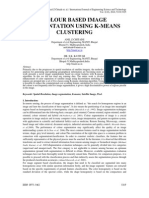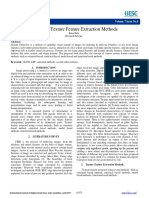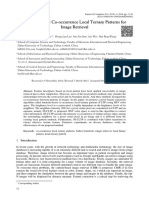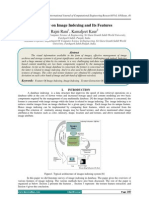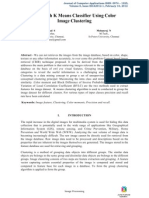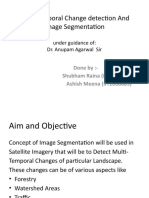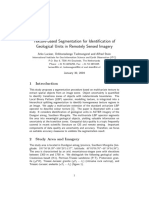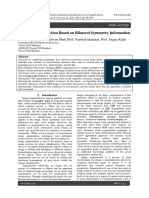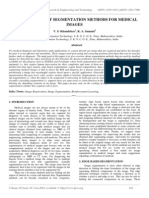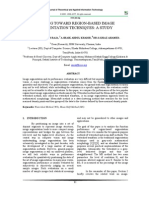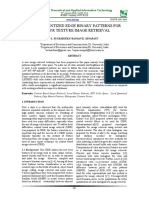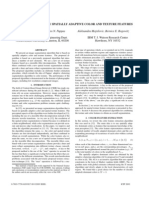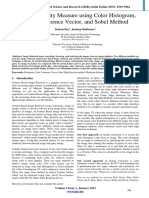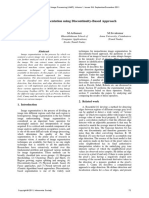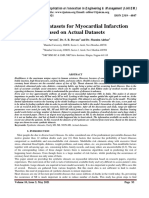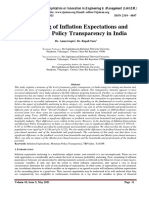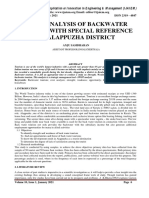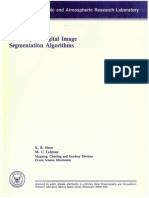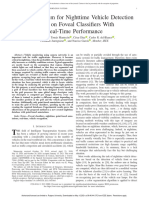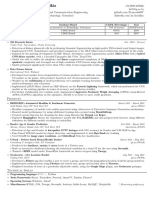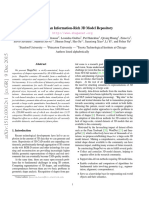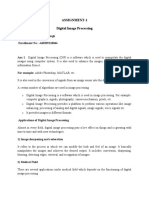Robust Rule Based Local Binary Pattern Method For Texture Classification and Analysis
Robust Rule Based Local Binary Pattern Method For Texture Classification and Analysis
Copyright:
Available Formats
Robust Rule Based Local Binary Pattern Method For Texture Classification and Analysis
Robust Rule Based Local Binary Pattern Method For Texture Classification and Analysis
Original Title
Copyright
Available Formats
Share this document
Did you find this document useful?
Is this content inappropriate?
Copyright:
Available Formats
Robust Rule Based Local Binary Pattern Method For Texture Classification and Analysis
Robust Rule Based Local Binary Pattern Method For Texture Classification and Analysis
Copyright:
Available Formats
International Journal of Emerging Trends & Technology in Computer Science (IJETTCS)
Web Site: www.ijettcs.org Email: editor@ijettcs.org, editorijettcs@gmail.com Volume 2, Issue 4, July August 2013 ISSN 2278-6856
Robust Rule Based Local Binary Pattern Method for Texture Classification and Analysis
O.Rama Devi 1, Dr. E.V.Prasad2, Dr.L.S.S.Reddy 3
2
Assistant Professor, P.V.P.S.I.T, AP, India Dean, Planning & Development, K. L. University, AP, India 3 Director, LBRCE, Mylavaram, A.P, India
Abstract: The
primary objective of texture image segmentation is to divide the image into uniform parts. Object extraction; object recognition and object-based compression is typical applications that use texture image segmentation as a low-level image processing. Texture Image segmentation is an important processing step in various image, video and computer vision applications. Extensive research has been done in creating many different approaches and algorithms for texture image segmentation, but it is still complex to assess whether one algorithm produces more accurate segmentation than another for a particular image or set of images, or for a whole category of images. A new texture segmentation approach, including a feature extraction method and the novel segmentation algorithm, is shown in this paper. The proposed feature extraction method called rule based local binary patterns (RLBP), selects the frequently occurred patterns to construct the main pattern set, which avoids the usage of same pattern set for describing different texture structures in traditional local binary patterns. According to the different morphologies and different semantics of texture, the segmentation algorithm is designed for texture segmentation based on RLBP features .As it is simple and efficient so our implementation is suitable for large-scale texture Images. The experiments exhibited the segmentation effect of the proposed method is satisfactory from human visual aspect and segmentation accuracy.
Keywords: RLBP, Texture Image segmentation, Objective evaluation, unsupervised evaluation, Empirical good measure.
1. INTRODUCTION
Image segmentation partitions an image into nonoverlapping regions. A region is defined as a homogeneous group of connected pixels with respect to a chosen property. There are several ways to define homogeneity of a region that are based on a particular objective in the segmentation process. For example, it may be measured by color, gray levels, texture, motion, depth of layers, etc. Overlaps among regions are not permitted; therefore, each pixel belongs only to a Single region. Two neighboring regions should be merged if the new combined region is homogeneous. Consequently, each region is anticipated to be as large as possible under its certain characterization. Then, the total number of regions is reduced. Since segmentation definition is Volume 2, Issue 4 July August 2013
informal, it is very difficult to propose semantics to measure the quality of a given segmentation, unless the segmentations goal is well defined. Image segmentation has a variety of purposes. For example, segmentation plays an important role in the field of video object extraction [13]. Since homogeneous regions correspond to meaningful objects (which are mostly inhomogeneous), many of the video object extraction algorithms first partition the image into homogeneous regions, and then, in order to extract the moving object, the regions are merged according to temporal information of the sequence. In image compression [46], the input image is divided into regions that should be separately compressed since better compression is achieved as long as the regions are more homogeneous. Tracking systems that are regionally based [79] utilize the information of the entire objects regions. They track the homogeneous regions of the object by their color, luminance or texture. Then, a merging technique that is based on motion estimation is used in order to obtain the complete object in the next frame. Image segmentation is also used in object recognition systems [10, 11]. Many of these system partition the object to be recognized into sub-regions and try to characterize each separately in order to simplify the matching process. Automatic segmentation in still image has been investigated [12, 13] by many researchers from diverse fields of sciences. The existing segmentation methods can be divided into the following primary approaches: 1) Histogram-based methods, 2) boundarybased methods, 3) region-based methods, 4) hybrid-based methods and 5) graph-based techniques. In the digital images, the spatial distributions of gray values choose the textural features and hence, statistical methods analyze the spatial allocation of pixel values in the digital image. Based on the number of pixels defining the local feature, statistical methods can be categorized into first-order statistical methods, second-order statistical methods and higher-order statistical methods [14]. A large number of statistical texture approaches have been proposed, range from first order statistics to higher order statistics. As first order statistical methods cannot model the texture completely, higher order statistics are generally used for texture analysis [15]. Gray level co-occurrence matrices [16], gray level differences [17] and Local Binary Patterns [18] are some of the popular second-order Page 274
International Journal of Emerging Trends & Technology in Computer Science (IJETTCS)
Web Site: www.ijettcs.org Email: editor@ijettcs.org, editorijettcs@gmail.com Volume 2, Issue 4, July August 2013 ISSN 2278-6856
statistical texture methods for texture analysis. Geometrical methods are founded on the concept that texture could be seen as a spatial association of texture primitives. 1n [19] proposed an idea in which the texture image is viewed as texture primitives, which are precise according to a placement rule and texture analysis is a process of identifying those primitives or the placement rule. In [20] used a Fourier spectrum of a texture image to detect texture periodicity for the texture analysis. In [21] examined the structures of texture patterns in terms of their translation symmetries for the texture analysis. In this paper robust rule based local binary pattern technique is implemented for texture classification and analysis.
3. RULE BASED LOCAL BINARY PATTERNS
Rule Based LBP can be generally described as discrete dynamic systems completely defined by a set of rules in a local neighborhood. The state of a system is represented as a regular grid, on which the rules apply to produce a new state. An interesting property of RLBP is that very simple rules can result in very complex behavior. Now consider sample window S3X3 and compare each pixel with significant centers of the sample window. All neighboring pixels with values greater than the center to be replaced with the value 1 otherwise replace them with 0 such that gray images is converted to binary image. On the binary image the following rules have been used to remove the uncertainty of texture classification. 1) Calculation of the column wise count on sample space S3X3 3 Xi= S (si, n) ; where n=1, 2,3 i=1 If Xi >=2 then Ci=1 Else Ci=0 2) Calculation of the row wise count on sample space S3X3 3 Yi= S (si, m) where m=1, 2,3 i=1 If Yiion>=2 then Ri=1; Else Ri=0;
2. LOCAL BINARY PATTERNS
The original LBP operator labels the pixels of an image by means of decimal numbers, which are called LBP codes that encode the local structure around each pixel. It proceeds thus, as illustrated in Fig. 1: every pixel is compared with its eight neighbors in a 3 3 neighborhood by subtracting the center pixel value; the resulting strictly negative values are encoded with 0, and the others with 1. For each given pixel, a binary number is obtained by concatenating all these binary values in a clockwise direction, which starts from the one of its topleft neighbor. The corresponding decimal value of the generated binary number is then used for labeling the given pixel. The derived binary numbers are referred to be the LBPs or LBP codes.
Figure 1 An example of the basic LBP operator. While the LBP was, invariant to monotonic changes in gray scale, it was supplemented by an autonomous measure of local contrast. Fig. 2 shows how the contrast measure (C) was derived. The average gray level below the center pixel is subtracted from that of the gray level above (or equal to) the center pixel. Two-dimensional distributions of the Local Binary Pattern (LBP) and local contrast technique were used as features. This operator was called LBP/C, and extremely good discrimination rates were reported through textures.
3) Calculate the count for left diagonal D1 and right diagonal D2 on sample space S3x3 4) From the new sample matrix like giving blow. R1 D1 C1 R2 C2 R3 D2 C3 5) Compute the LBP operator on new sample space and replace the center pixel. 6) Repeat step 1 through step5 on entire images and form the new unambiguous image. The result of this method can be conveniently represented a two-dimensional pattern that can be further be used in image processing. RLBP of 8-bit, segments the Image in better way even for Noisy Images and the quality of the images are found to be better than images obtained with the conventional methods.
LBP = 1+2+4+8+128 = 143 C = (5+4+3+4+3)/5 (1+2+0)/3 = 2.8 Figure 2 Calculating the original LBP code and a contrast measure. Volume 2, Issue 4 July August 2013
4. EXPERIMENTAL RESULTS
Page 275
International Journal of Emerging Trends & Technology in Computer Science (IJETTCS)
Web Site: www.ijettcs.org Email: editor@ijettcs.org, editorijettcs@gmail.com Volume 2, Issue 4, July August 2013 ISSN 2278-6856
In order to verify the effectiveness of the segmentation process using the proposed method, a group of images of different kinds were tested. The performance evaluation of two methods has been described based on tables of values and graphs shown in the paper. Three texture images of mud, cliff and sand of different soil images have been shown in Fig 3, Fig 4 & Fig 5 of size 256X256 were considered in this experiment. Each individual texture image is considered as a model sample and there are 3 model samples in total. Each test sample is compared using RLBP and LBPC and classified. Table1 & Table2 show the classification performance of the proposed texture model and LBPC. From the Table2, it is observed that the classification results are excellent with high classification accuracy. The result of the comparison is given in the form of graphs shown in Fig 6 & Fig 7. In the case of LBPC texture model does not classify three categories clearly. RLBP method is considered as a good texture classifier, it clearly classifies all three types of images. Among the two texture methods under consideration, the proposed RLBP texture method delivers superior classification. Table 2: RBPR
Mud 0.531 0.559 0.535 0.538 0.527 0.546 0.582 0.546 0.54 0.549 Cliff 0.609 0.614 0.555 0.556 0.584 0.55 0.609 0.598 0.599 0.6 Sand 0.527 0.516 0.514 0.514 0.517 0.527 0.529 0.519 0.534 0.547
Figure 6 LBPC
Figure 3 Mud Images
Figure 7 RLBP
5. CONCLUSIONS
The LBP operator has been theoretically simple yet a very powerful method of analyzing textures. Through the extension developed during this paper, the RLBP operator was made into a really powerful measure of image texture showing outstanding results in terms of accuracy and computational complexity in many empirical studies. In this paper, we analyzed LBPC and consequently a new scheme, namely RLBP is proposed. Two operators, LBPC and RLBP are defined to classify the texture images. Finally, RLBP operator gives much better texture classification accuracy than LBPC operator which obtained. The RPBP operator doesn't classify rough and mud images.
Figure 4 Cliff Images
Figure 5 Sand Images Table1: LBPC
Mud Image 0.556 0.608 0.555 0.561 0.525 0.567 0.611 0.568 0.562 0.591 Cliff ImagLVPC 0.628 0.661 0.662 0.59 0.58 0.5 0.582 0.57 0.55 0.565 Sand 0.553 0.511 0.497 0.505 0.542 0.549 0.519 0.518 0.51 0.558
References
[1] D. Wang, Unsupervised video segmentation based on watersheds and Temporal tracking, IEEE Transactions on Circuits and Systems for Video Technology 8 (5) (1998). [2] H. Gao, W. -C. Siu, C. -H. Hou, Improved techniques for automatic image segmentation, IEEE Transactions on Circuits and Systems for Video Technology 11 (12) (2001). [3] F. Dufaux, F. Moscheni, A. Lippman, Spatiotemporal segmentation based on motion and static segmentation, IEEE Proceedings of International Page 276
Volume 2, Issue 4 July August 2013
International Journal of Emerging Trends & Technology in Computer Science (IJETTCS)
Web Site: www.ijettcs.org Email: editor@ijettcs.org, editorijettcs@gmail.com Volume 2, Issue 4, July August 2013 ISSN 2278-6856
Conference on Image Processing 95, Washington, DC, October 1995. [4] P. Suetens, P. Fua, A.J. Hanson, Computational strategies for object recognition, ACM Computing Surveys 24 (1992) 561. [5] P. Bessel, R. Jain, Three-dimensional object recognition, ACMComputing Surveys 17 (1985) 75145. [5] M. Kunt, M. Benard, R. Leonardi, Recent results in higher compression image coding, IEEE Transactions on Circuits and Systems 34 (1987)13061336. [6] K. Belloulata, J. Konrad, Fractal Image compression with region based functionality, IEEE Transactions on Image Processing 11 (4) (2002) 351. [7] E. Ozyildiz, N. Krahnst-over, R. Sharm, Adaptive texture and color segmentation for tracking moving objects, Pattern Recognition 35 (2002) 20132029. [8] D.S. Yang, H.I. Choi, Moving object tracking by optimizing models, Proceedings of the International Conference on Pattern Recognition, Brisbane, Australia, 1998, pp. 738740. [9] R. Murrieta-CID, M. Briot, N. Vandapel, Landmark identification and tracking in natural environment, IEEE International Conference on Intelligent Robots and Systems, Victoria, BC, Canada, 1998, pp. 738740 [10] N. Pal, S. Pal, A review of image segmentation techniques, Pattern Recognition 26 (1993) 1277 1294. [11] R.M. Haralick, L.G. Shapiro, Survey: image segmentation techniques, Computer Vision, Graphics and Image Processing 29 (1985) 100132. [12] B. Schacter, L. Davis, A. Rosenfeld, Scene Segmentation by Cluster Detection in Color Space, Department of Computer Science, University of Maryland, College Park, MD, 1975. [13] A. Sarabi, J.K. Aggarwal, Segmentation of chromatic images, Pattern Recognition 13 (6) (1981) 417427. [14] Ojala, T., Pietikinen, M., Harwood, D.: A Comparative Study of Texture Measures with Classification Based on Feature Distributions. Pattern Recognition 29(1996) 51-59 [15] Ojala, T., Pietikinen, M., Menp, T.: Multiresolution Grayscale and Rotation Invariant Texture Classification with Local Binary Patterns. IEEE Transactions on Pattern Analysis and Machine Intelligence 24 (2002) 971 987 118 M. Pietikinen [16] Menp, T., Pietikinen, M.: Texture Analysis with Local Binary Patterns. In: Chen, C.H., Wang, P.S.P. (Eds.): Handbook of Pattern Recognition and Computer Vision, 3rdedn. World Scientific (2005) 197-216 [17] http://www.ee.oulu.fi/research/imag/texture/ [18] Ojala, T. And M. Pietikainen, 2004. Texture Classification. Machine Vision and Media Processing Unit University of Oulu, Finland. [19] Moasheri, B.B.M. And S. Azadinia, 2011. A new voting approach to texture defect detection based on Volume 2, Issue 4 July August 2013 multiresolutional decomposition. World Acad. SCI., Eng. Technol., 73: 657-661. [20] Haralick, R.M., K. Shanmugam and I. Dinstein, 1973.Textural features for image classification. IEEETrans. Syst. Man Cybernetics, 3: 610-621. DOI:10.1109/TSMC.1973.4309314 [21] Weszka, J.S., C.R. Dyer and A. Rosenfeld, 1976. A comparative study of texture measures for terrain classification. IEEE Trans. Syst. Man Cybernetics, 6: 269-285. DOI:10.1109/TSMC.1976.5408 777
AUTHORS
O. Rama Devi received her B. Tech degree in CSE from K. L. College of Engineering, Guntur. M. Tech degree in Computer Science from K. L. College of Engineering, Guntur. Currently, she is pursuing her PhD at JNTUK, Kakinada. And she is working as Asst. Professor in P. V. P. Siddhartha Institute of Technology, Kanuru. She has 6 years of teaching experience .She has published 4 research papers in various national and international journals and attended 10 national and international conferences. Her interesting subjects are image processing, computer networks and pattern recognition. She is a member of CSI professional societies. Dr. E. V. Prasad Dean, Planning and development, K. L. University .He was retired as a rector, JNTU Kakinada. He held different positions Principal, Director, Registar and act as a BOS Chairman. And supervised 7 PhD students and 8 students working for their degree. He is the Co author of six books and published hundred papers in national and International journals and conferences. His research interests include Data Mining, and Information Security. Dr. L. S. S. Reddy received his B. Tech degree in Electronics and communication Engineering from J. N. T. University Hyderabad, M. Phil degree in Computer Science from Central University Hyderabad and PhD from BITS, PILANI. Currently, he is director of the Lakireddy Balireddy College of Engineering, Mylavaram, Andhra Pradesh. He has got more than 20 years of teaching experience .He has published fifty two research papers in various national and international journals and more than twenty research papers in various national and international conferences. He is Chairman Board of study in Nagarjuna University. He guided four PhD scholars and Chairman of CSI Chapter, Vijayawada. He is a member of various professional societies like IEEE, ISTE, IETE, IE and CSI.
Page 277
You might also like
- Digital Image Processing Question PaperDocument4 pagesDigital Image Processing Question PaperGiri KandeNo ratings yet
- Object Recognition Using Visual CodebookDocument5 pagesObject Recognition Using Visual CodebookInternational Journal of Application or Innovation in Engineering & ManagementNo ratings yet
- A Fast Image Segmentation Algorithm Based On Saliency Map and Neutrosophic Set TheoryDocument12 pagesA Fast Image Segmentation Algorithm Based On Saliency Map and Neutrosophic Set TheoryScience DirectNo ratings yet
- Color Based SegmentationDocument7 pagesColor Based SegmentationZaib Un Nisa HafeezNo ratings yet
- Feature Extraction For Image Retrieval Using Image Mining TechniquesDocument7 pagesFeature Extraction For Image Retrieval Using Image Mining TechniquesresearchinventyNo ratings yet
- 9roburst For Facerecog PDFDocument4 pages9roburst For Facerecog PDFRama DeviNo ratings yet
- Block Texture Pattern Detection Based On Smoothness and Complexity of Neighborhood PixelsDocument9 pagesBlock Texture Pattern Detection Based On Smoothness and Complexity of Neighborhood PixelsHoài AnNo ratings yet
- IntroductionDocument35 pagesIntroductionAshish ambasthaNo ratings yet
- Tekstur ClassificationDocument7 pagesTekstur ClassificationJosua BiondiNo ratings yet
- Survey On Texture Feature Extraction MethodsDocument3 pagesSurvey On Texture Feature Extraction MethodsElearning Ubsi100% (1)
- I Ji Scs 01112012Document11 pagesI Ji Scs 01112012WARSE JournalsNo ratings yet
- Joc 2904 02Document19 pagesJoc 2904 02PRABHAKARANNo ratings yet
- A Study On Image Indexing and Its Features: Rajni Rani, Kamaljeet KaurDocument4 pagesA Study On Image Indexing and Its Features: Rajni Rani, Kamaljeet KaurInternational Journal of computational Engineering research (IJCER)No ratings yet
- Image ClusteringDocument6 pagesImage ClusteringSayian ManiNo ratings yet
- Feature Integration For Image Information Retrieval Using Image Mining TechniquesDocument9 pagesFeature Integration For Image Information Retrieval Using Image Mining TechniquesIAEME PublicationNo ratings yet
- Convertion of Mri Spine Images Into Colour Image SegementationDocument13 pagesConvertion of Mri Spine Images Into Colour Image SegementationShay Patrick CormacNo ratings yet
- Content Based Image Retrieval Based On Color, Texture and Shape Features Using Image and Its ComplementDocument11 pagesContent Based Image Retrieval Based On Color, Texture and Shape Features Using Image and Its ComplementPrakash PattanNo ratings yet
- Efficient Graph-Based Image SegmentationDocument15 pagesEfficient Graph-Based Image SegmentationrooocketmanNo ratings yet
- Local Pattern Based CbirDocument13 pagesLocal Pattern Based Cbirdilkeshwar pandeyNo ratings yet
- Domain Specific Cbir For Highly Textured ImagesDocument7 pagesDomain Specific Cbir For Highly Textured ImagescseijNo ratings yet
- BTC With K Means Classifier Using Color Image ClusteringDocument7 pagesBTC With K Means Classifier Using Color Image ClusteringJournal of Computer ApplicationsNo ratings yet
- Comparison of Image Segmentation Algorithms: Volume 2, Issue 3, May - June 2013Document4 pagesComparison of Image Segmentation Algorithms: Volume 2, Issue 3, May - June 2013International Journal of Application or Innovation in Engineering & ManagementNo ratings yet
- Multi-Temporal Change Detection and Image Segmentation: Under Guidance Of: Dr. Anupam Agarwal SirDocument19 pagesMulti-Temporal Change Detection and Image Segmentation: Under Guidance Of: Dr. Anupam Agarwal SirAshish MeenaNo ratings yet
- Image Segmentation PDFDocument6 pagesImage Segmentation PDFKrishna KumarNo ratings yet
- Integrating Image Segmentation and Classification Using Texture Primitives For Natural and Aerial ImagesDocument8 pagesIntegrating Image Segmentation and Classification Using Texture Primitives For Natural and Aerial ImagesInternational Journal of Application or Innovation in Engineering & ManagementNo ratings yet
- Texture-Based Segmentation Remote SenseDocument4 pagesTexture-Based Segmentation Remote SenseJorge HinostrozaNo ratings yet
- 3 mmPSODocument21 pages3 mmPSOGoran WnisNo ratings yet
- Perception Based Texture Classification, Representation and RetrievalDocument6 pagesPerception Based Texture Classification, Representation and Retrievalsurendiran123No ratings yet
- A Novel Fusion Approach To Content-Based Image Retrieval: Xiaojun Qi, Yutao HanDocument17 pagesA Novel Fusion Approach To Content-Based Image Retrieval: Xiaojun Qi, Yutao HanManda RohandiNo ratings yet
- IJETR031551Document6 pagesIJETR031551erpublicationNo ratings yet
- Review of Graph, Medical and Color Image Base Segmentation TechniquesDocument67 pagesReview of Graph, Medical and Color Image Base Segmentation TechniquesFidel SouzaNo ratings yet
- 1412 3009 PDFDocument6 pages1412 3009 PDFJacob JayaseelanNo ratings yet
- (IJIT-V10I5P3) :sinda Alexander Mwikwabe, Dr. Nambiro Alice, PHD, Dr. Anselemo Peters PHDDocument6 pages(IJIT-V10I5P3) :sinda Alexander Mwikwabe, Dr. Nambiro Alice, PHD, Dr. Anselemo Peters PHDIJIT EditorNo ratings yet
- Extended Rule Base Local Binary Pattern Technique For Texture Classification and AnalysisDocument6 pagesExtended Rule Base Local Binary Pattern Technique For Texture Classification and AnalysisRama DeviNo ratings yet
- A Brief Review of Segmentation Methods For MedicalDocument7 pagesA Brief Review of Segmentation Methods For MedicalInternational Journal of Research in Engineering and TechnologyNo ratings yet
- Color Image Segmentation Advantages and ProspectsDocument43 pagesColor Image Segmentation Advantages and ProspectsDak IanNo ratings yet
- Moving Toward Region-Based Image Segmentation Techniques: A StudyDocument7 pagesMoving Toward Region-Based Image Segmentation Techniques: A StudyDeepak MohanNo ratings yet
- Journal of Computer Applications - WWW - Jcaksrce.org - Volume 4 Issue 2Document5 pagesJournal of Computer Applications - WWW - Jcaksrce.org - Volume 4 Issue 2Journal of Computer ApplicationsNo ratings yet
- Color Histogram For Content-Based Image RetrievalDocument7 pagesColor Histogram For Content-Based Image RetrievalRakeshconclaveNo ratings yet
- A Survey: Image Segmentation Techniques: Muhammad Waseem KhanDocument5 pagesA Survey: Image Segmentation Techniques: Muhammad Waseem KhanWaseem KhanNo ratings yet
- LQEBPDocument13 pagesLQEBPSuchi ReddyNo ratings yet
- Edge Detection Techniques For Image SegmentationDocument9 pagesEdge Detection Techniques For Image SegmentationAnonymous Gl4IRRjzNNo ratings yet
- Junqing Chen, Thrasyvoulos N. Pappas Aleksandra Mojsilovic, Bernice E. RogowitzDocument4 pagesJunqing Chen, Thrasyvoulos N. Pappas Aleksandra Mojsilovic, Bernice E. RogowitzanasunislaNo ratings yet
- Analysis and Comparison of Texture Features For Content Based Image RetrievalDocument6 pagesAnalysis and Comparison of Texture Features For Content Based Image RetrievalEdwin SinghNo ratings yet
- Modified Color Based Edge Detection of Remote Sensing Images Using Fuzzy LogicDocument5 pagesModified Color Based Edge Detection of Remote Sensing Images Using Fuzzy LogicInternational Journal of Application or Innovation in Engineering & ManagementNo ratings yet
- Image Similarity Measure Using Color Histogram, Color Coherence Vector, and Sobel MethodDocument6 pagesImage Similarity Measure Using Color Histogram, Color Coherence Vector, and Sobel MethodIjsrnet EditorialNo ratings yet
- Evaluation of Texture Features For Content-Based Image RetrievalDocument9 pagesEvaluation of Texture Features For Content-Based Image RetrievalliketoendNo ratings yet
- Comparative Analysis of Structure and Texture Based Image Inpainting TechniquesDocument8 pagesComparative Analysis of Structure and Texture Based Image Inpainting TechniquesAnanda RamanNo ratings yet
- Color Image Segmentation: Advances and Prospects: H.D. Cheng, X.H. Jiang, Y. Sun, Jingli WangDocument23 pagesColor Image Segmentation: Advances and Prospects: H.D. Cheng, X.H. Jiang, Y. Sun, Jingli WangJuan David Leal CampuzanoNo ratings yet
- Image Segmentation Using Discontinuity-Based Approach: Rajiv Kumar M.Arthanari M.SivakumarDocument7 pagesImage Segmentation Using Discontinuity-Based Approach: Rajiv Kumar M.Arthanari M.SivakumarMohan Reddy KandiNo ratings yet
- Texture Segmentation Using LBP Embedded Region Competition: Xu Qing, Yang Jie, Ding SiyiDocument7 pagesTexture Segmentation Using LBP Embedded Region Competition: Xu Qing, Yang Jie, Ding SiyizhalanNo ratings yet
- Improved Color Edge Detection by Fusion of Hue, PCA & Hybrid CannyDocument8 pagesImproved Color Edge Detection by Fusion of Hue, PCA & Hybrid CannyVijayakumarNo ratings yet
- Image Segmentation: Department of Computer Engineering ACSDocument3 pagesImage Segmentation: Department of Computer Engineering ACSIJSTENo ratings yet
- fmm-cvpr03 PDFDocument8 pagesfmm-cvpr03 PDFSungkwan ParkNo ratings yet
- Evaluation and Performance Analysis of Brain MRI Segmentation MethodsDocument10 pagesEvaluation and Performance Analysis of Brain MRI Segmentation MethodsNaresh GhorpadeNo ratings yet
- 5 - AshwinKumar - FinalPaper - IISTE Research PaperDocument6 pages5 - AshwinKumar - FinalPaper - IISTE Research PaperiisteNo ratings yet
- Brain Tumor Extraction From MRI Images Using Matlab: A State ArtDocument4 pagesBrain Tumor Extraction From MRI Images Using Matlab: A State ArtCristian Marq'zNo ratings yet
- Image Segmentation Using Discontinuity Based ApproachDocument7 pagesImage Segmentation Using Discontinuity Based Approach18H51A05C3-Ande Dheeraj Reddy B.Tech CSE (2018-22)No ratings yet
- Color Feature Based Object Localization in Real Time ImplementationDocument7 pagesColor Feature Based Object Localization in Real Time ImplementationPoitu ErmawantiaNo ratings yet
- Fast Texture Segmentation Based On Semi-Local Region Descriptor and Active ContourDocument24 pagesFast Texture Segmentation Based On Semi-Local Region Descriptor and Active ContourParthesh MankodiNo ratings yet
- Study of Customer Experience and Uses of Uber Cab Services in MumbaiDocument12 pagesStudy of Customer Experience and Uses of Uber Cab Services in MumbaiInternational Journal of Application or Innovation in Engineering & ManagementNo ratings yet
- Detection of Malicious Web Contents Using Machine and Deep Learning ApproachesDocument6 pagesDetection of Malicious Web Contents Using Machine and Deep Learning ApproachesInternational Journal of Application or Innovation in Engineering & ManagementNo ratings yet
- Analysis of Product Reliability Using Failure Mode Effect Critical Analysis (FMECA) - Case StudyDocument6 pagesAnalysis of Product Reliability Using Failure Mode Effect Critical Analysis (FMECA) - Case StudyInternational Journal of Application or Innovation in Engineering & ManagementNo ratings yet
- An Importance and Advancement of QSAR Parameters in Modern Drug Design: A ReviewDocument9 pagesAn Importance and Advancement of QSAR Parameters in Modern Drug Design: A ReviewInternational Journal of Application or Innovation in Engineering & ManagementNo ratings yet
- THE TOPOLOGICAL INDICES AND PHYSICAL PROPERTIES OF n-HEPTANE ISOMERSDocument7 pagesTHE TOPOLOGICAL INDICES AND PHYSICAL PROPERTIES OF n-HEPTANE ISOMERSInternational Journal of Application or Innovation in Engineering & ManagementNo ratings yet
- Staycation As A Marketing Tool For Survival Post Covid-19 in Five Star Hotels in Pune CityDocument10 pagesStaycation As A Marketing Tool For Survival Post Covid-19 in Five Star Hotels in Pune CityInternational Journal of Application or Innovation in Engineering & ManagementNo ratings yet
- Soil Stabilization of Road by Using Spent WashDocument7 pagesSoil Stabilization of Road by Using Spent WashInternational Journal of Application or Innovation in Engineering & ManagementNo ratings yet
- Study of Customer Experience and Uses of Uber Cab Services in MumbaiDocument12 pagesStudy of Customer Experience and Uses of Uber Cab Services in MumbaiInternational Journal of Application or Innovation in Engineering & ManagementNo ratings yet
- Performance of Short Transmission Line Using Mathematical MethodDocument8 pagesPerformance of Short Transmission Line Using Mathematical MethodInternational Journal of Application or Innovation in Engineering & ManagementNo ratings yet
- The Mexican Innovation System: A System's Dynamics PerspectiveDocument12 pagesThe Mexican Innovation System: A System's Dynamics PerspectiveInternational Journal of Application or Innovation in Engineering & ManagementNo ratings yet
- A Comparative Analysis of Two Biggest Upi Paymentapps: Bhim and Google Pay (Tez)Document10 pagesA Comparative Analysis of Two Biggest Upi Paymentapps: Bhim and Google Pay (Tez)International Journal of Application or Innovation in Engineering & ManagementNo ratings yet
- An Importance and Advancement of QSAR Parameters in Modern Drug Design: A ReviewDocument9 pagesAn Importance and Advancement of QSAR Parameters in Modern Drug Design: A ReviewInternational Journal of Application or Innovation in Engineering & ManagementNo ratings yet
- Design and Detection of Fruits and Vegetable Spoiled Detetction SystemDocument8 pagesDesign and Detection of Fruits and Vegetable Spoiled Detetction SystemInternational Journal of Application or Innovation in Engineering & ManagementNo ratings yet
- A Deep Learning Based Assistant For The Visually ImpairedDocument11 pagesA Deep Learning Based Assistant For The Visually ImpairedInternational Journal of Application or Innovation in Engineering & ManagementNo ratings yet
- Synthetic Datasets For Myocardial Infarction Based On Actual DatasetsDocument9 pagesSynthetic Datasets For Myocardial Infarction Based On Actual DatasetsInternational Journal of Application or Innovation in Engineering & ManagementNo ratings yet
- Impact of Covid-19 On Employment Opportunities For Fresh Graduates in Hospitality &tourism IndustryDocument8 pagesImpact of Covid-19 On Employment Opportunities For Fresh Graduates in Hospitality &tourism IndustryInternational Journal of Application or Innovation in Engineering & ManagementNo ratings yet
- Design and Manufacturing of 6V 120ah Battery Container Mould For Train Lighting ApplicationDocument13 pagesDesign and Manufacturing of 6V 120ah Battery Container Mould For Train Lighting ApplicationInternational Journal of Application or Innovation in Engineering & ManagementNo ratings yet
- Anchoring of Inflation Expectations and Monetary Policy Transparency in IndiaDocument9 pagesAnchoring of Inflation Expectations and Monetary Policy Transparency in IndiaInternational Journal of Application or Innovation in Engineering & ManagementNo ratings yet
- Ijaiem 2021 01 28 6Document9 pagesIjaiem 2021 01 28 6International Journal of Application or Innovation in Engineering & ManagementNo ratings yet
- The Effect of Work Involvement and Work Stress On Employee Performance: A Case Study of Forged Wheel Plant, IndiaDocument5 pagesThe Effect of Work Involvement and Work Stress On Employee Performance: A Case Study of Forged Wheel Plant, IndiaInternational Journal of Application or Innovation in Engineering & ManagementNo ratings yet
- Swot Analysis of Backwater Tourism With Special Reference To Alappuzha DistrictDocument5 pagesSwot Analysis of Backwater Tourism With Special Reference To Alappuzha DistrictInternational Journal of Application or Innovation in Engineering & ManagementNo ratings yet
- A Concept Exploration Method For Product Family DesignDocument598 pagesA Concept Exploration Method For Product Family DesignHariton FloreaNo ratings yet
- Thesis FinalDocument3 pagesThesis FinalChristian ViernesNo ratings yet
- ADA499374Document29 pagesADA499374E-Merson AbdisaNo ratings yet
- Coloured Night VisionDocument13 pagesColoured Night Visionali razaNo ratings yet
- Basepaper ngt1Document13 pagesBasepaper ngt1Lakshmana Nainar Sundar S.No ratings yet
- Goyal 2018Document12 pagesGoyal 2018ahmad asadullahNo ratings yet
- Robotics Chapter 5 - Robot VisionDocument7 pagesRobotics Chapter 5 - Robot Visiontutorfelix777No ratings yet
- Handwritten Digit Recognition of MNIST Dataset Using Deep Learning State-Of-The-Art Artificial Neural Network ANN and Convolutional Neural Network CNNDocument7 pagesHandwritten Digit Recognition of MNIST Dataset Using Deep Learning State-Of-The-Art Artificial Neural Network ANN and Convolutional Neural Network CNNSubramanian SubbuNo ratings yet
- Depth Anything: Unleashing The Power of Large-Scale Unlabeled DataDocument18 pagesDepth Anything: Unleashing The Power of Large-Scale Unlabeled Dataroyalatlas.stashNo ratings yet
- Image Processing IEEE ProjectsDocument4 pagesImage Processing IEEE ProjectsTema Solutions0% (1)
- Detection of Abandoned Objects in Crowded Environments: June 2016Document16 pagesDetection of Abandoned Objects in Crowded Environments: June 2016ShyleshNo ratings yet
- (PDF Download) Image Segmentation: Principles, Techniques, and Applications Tao Lei Fulll ChapterDocument64 pages(PDF Download) Image Segmentation: Principles, Techniques, and Applications Tao Lei Fulll Chapterrotenpikina100% (5)
- Thresholding in Image ProcessingDocument21 pagesThresholding in Image ProcessingArushi SrivastavaNo ratings yet
- Abnormal Vehicle Behavior Detection Using Deep Learning and Computer VisionDocument8 pagesAbnormal Vehicle Behavior Detection Using Deep Learning and Computer VisionInternational Journal of Innovative Science and Research TechnologyNo ratings yet
- A Frame Work For Image ProcessingDocument13 pagesA Frame Work For Image ProcessingKhairul MuzafarNo ratings yet
- 3D Shape Analysis Using The CNNDocument6 pages3D Shape Analysis Using The CNNhsisjNo ratings yet
- Fabric Defect Detection Using Computer Vision Techniques ADocument24 pagesFabric Defect Detection Using Computer Vision Techniques AhiengineerNo ratings yet
- 1 s2.0 S0957417423014720 MainDocument15 pages1 s2.0 S0957417423014720 MainAngel David Cano RendonNo ratings yet
- PhotutilsDocument401 pagesPhotutilsBurak BaşoğluNo ratings yet
- Sambre Kar 2015Document6 pagesSambre Kar 2015DHRUBAJIT KAKATINo ratings yet
- Franchis ResumeDocument2 pagesFranchis ResumeArnav MishraNo ratings yet
- Computer Vision Applications With C# - Fuzzy C-Means Clustering - CodeProjectDocument6 pagesComputer Vision Applications With C# - Fuzzy C-Means Clustering - CodeProjectHaimặtcủa MộtĐồng TiềnNo ratings yet
- Satellite Image Processing Research PapersDocument6 pagesSatellite Image Processing Research Papersgz49w5xr100% (1)
- Robo PDFDocument2 pagesRobo PDFRajamuthamilselvan MarimuthuNo ratings yet
- Texture Analysis Using Gabor FiltersDocument38 pagesTexture Analysis Using Gabor FiltersRajkumar KondappanNo ratings yet
- Saravanan ThesisDocument207 pagesSaravanan ThesisUnimarks Legal Solutions100% (1)
- MRI Brain Tumor Detection Methods Using Contourlet Transform Based On Time Adaptive Self-Organizing MaDocument13 pagesMRI Brain Tumor Detection Methods Using Contourlet Transform Based On Time Adaptive Self-Organizing MaNeha PinnamarajuNo ratings yet
- ShapeNet: An Information-Rich 3D Model RepositoryDocument11 pagesShapeNet: An Information-Rich 3D Model RepositorykensaiiNo ratings yet
- Assignment-1 Digital Image ProcessingDocument8 pagesAssignment-1 Digital Image ProcessingNiharika SinghNo ratings yet



